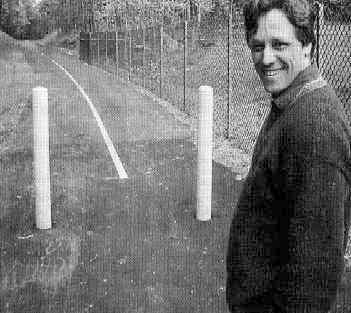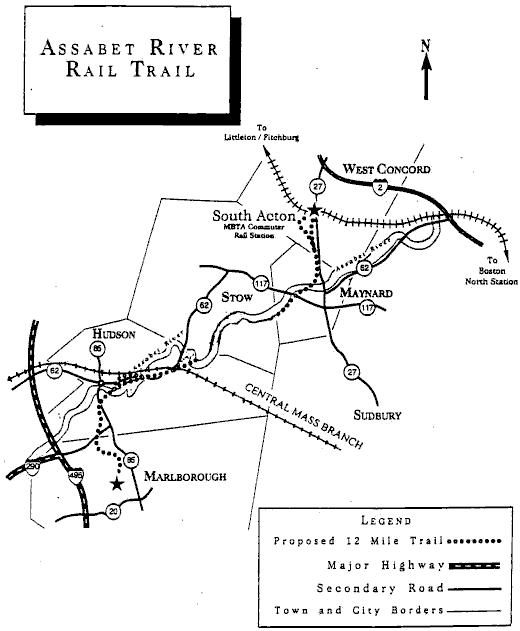
Top: Home Page
Up: Table of Contents
Nonstandard, hazardous barrier openings
My comment letter to MassHighway
Commonwealth's response to my comment letter
Sidepath proposed as section of trail
My letter commenting on sidepath proposal
I have also produced a photo tour
of this trail.
Photo from the Metrowest Daily News,
Friday, May 18, 2001.
WHAT'S WRONG WITH THIS PICTURE?

| Suppose a number of bicyclists are headed toward each other on
the trail, and will meet at the barrier in the picture, and the trail is crowded. For what direction of travel is the middle one of the three openings designated? Think about it. A bicyclist approaching the barrier has the choice either to ride into the center opening, which is too narrow for two-way traffic, or ride around the outside in the dirt, because the pavement outside the posts is too narrow for one-way travel.The situation is worse when the trail is crowded. There will be head-on collisions. Some bicyclists will be slammed to the ground when a handlebar end catches on one of the posts. Other bicyclists will ride around the outside in the dirt and be slammed onto the pavement because their tires catch on the edge of the pavement. . Several Massbike members ran into exactly the same issue of a path's being divided three ways in reviewing the plans for the Minuteman path several years ago. We got that changed, and we also got bicycle mazes toned down so it would be possible to get a tandem, a bicycle trailer or a wheelchair through them. In the original design, the path would not have been accessible to anything wider than a conventional bicycle. The narrow passages would have created traffic jams at the intersections, too, with people piling up out into the street. The bicycle mazes were, of course, intended as a safety measure. We got to review the Minuteman project because the town engineer of one of the towns along the path was alarmed about these problems. The impetus for such review was from the town, not from the Highway Department, which is responsible for design of most such projects. During the comment period for the Assabet River Rail Trail, I sent the following letter to the Highway department, and received a response. Both are included below. And there's more. Read on -- Read my letter as text below, or view my letter as it appeared on my stationery May 23, 2001 By mail, and fax to 617 973-8032 Re: Assabet Rail Trail Dear Mr. Broderick: I am a past president of the Massachusetts Bicycle Coalition and author of reports on bicycle facilities for the Commonwealth, including one on the Metrowest area, reporting to Cathy Buckley Lewis of the CTPS. I have the following comments on the Assabet Rail Trail: 1) This is a generally useful and attractive project. However, the project should be regarded as a supplement to, not a substitution for, travel on streets and highways in the area. Most trip origins and destinations are accessible only via these. The trail will increase travel on many streets and roads by encouraging bicycle use. The trail will at times be crowded, pedestrians and inline skaters will reduce safe travel speeds, and bicyclists who are in a hurry will use the roads instead. In winter, roads will remain passable at times when the trail is not. For these reasons, the priorities of the Department and of municipalities should include maintaining and improving the streets and roads for bicycle travel. 2) Trails are popular with less-experienced bicyclists, including children. Careful design of road crossings is essential, with bold markings and adequate sight distances. At high-traffic intersections, signalization or grade separations should be considered. A grade separation at the Route 85 Connector is essential to maintain connectivity of the trail. 3) A report on the opening of the first section of the trail in Marlborough (Metrowest Daily News, May 18, 2001, page B2) showed a barrier configuration with two barrier posts, one in the middle of each lane of the trail. This configuration creates a center lane with an undefined direction of travel, inviting head-on collisions, and outside lanes which are too narrow for safe travel. Barrier posts should be placed at the center, and if necessary, the edges, of the trail, with a spacing of 5 feet, as specified in AASHTO guidelines for bicycle facilities. 4) In other respects as well, the project should conform to AASHTO guidelines, including those for sight distances, curve radii and lateral clearance.
Very truly yours,
John S. Allen I received a response to my letter as follows: *** Read the response below, or view the response as received on MHD stationery
John S. Allen Dear Mr. Allen: I am responding to your letter of May 23, 2001, regarding the Assabet River Rail Trail. MassHighway shares your view that this trail should be considered as a complement to the existing network of roadways and bridges. We support the view of the American Association of State Highway and Transportation Officials (AASHTO) that trails "should be thought of as a complementary system of off-road transportation routes for bicyclists and others that serves as a necessary extension to the roadway network." (AASHTO Guide for the Development of Bicycle Facilities, 1999 Edition, page 33.) Not only does MassHighway support that view, but we have distributed the AASHTO Guide to all 351 Commonwealth communities, as well as to all the regional planning agencies and transit authorities, and to many libraries statewide. Thank you for your recommendations on design details. I recommend that you attend the design hearing for the 25% phase of the Assabet River Rail Trail, which will be held in the near future. Your views will certainly be welcome. I will also forward your recommendation on barrier post locations to MassHighway's District Four for consideration during the design review. Thank you again for interest in and support for the Assabet River Rail Trail, one of the many off-road bicycle projects now either in design or construction. MassHighway appreciates all the excellent and detailed site work you undertook in assisting production of the prior Massachusetts Bicycle Map and the current Berkshire Bicycle Touring Guide, being funded by MassHighway and produced by the Department of Environmental Management. Should you have any additional questions or concerns, do not hesitate to contact me at (617) 973-7858 or Josh Lehman, at (617) 973-7329.
Allen Assabet ltr Around the same time, I read a report of the Senate Committee on Post Audit and Oversight, Getting on Track. It included the following mention of the Assabet River Rail Trail: "the Stow section was sold off to a variety of private interests roughly 40 years ago.[23] Due to the cost and complexity of trying to recreate a contiguous rail trail line through Stow, the trail may need to travel alongside the road until it can reconnect in Marlborough or Maynard. A map of the proposed trail is on the next page." (The map is reproduced here. Note the gap in the middle of the trail).
|

| Trails that run alongside roads like sidewalks ARE sidewalks, and have been proven
more hazardous than riding on the road in one study after another, here and in Europe. See
the Pasanen, Wachtel/Lewiston and Kaplan studies
accessible through this Web site. AASHTO guidelines for bicycle facilities specifically
recommend against sidewalk-type placement for trails, recommending improvement of the
roads, or trails away from roads. The obsession with creating a continuous trail is based
on the false idea that road riding is unacceptable and that all trails effect safety
improvements, with a good dose of community desire for sidewalks that they don't have to
pay for. I found it disturbing that a sidepath is being mentioned as a section of the
Assabet River Rail Trail, and sent the following letter:
Read my letter below, or view view my letter as it appeared on my stationery July 19, 2001 Ms. Luisa Paiewonsky, Director Re: Assabet Rail Trail Dear Ms. Paiewonsky: Thank you for your letter of June 8, 2001 in response to my comments on the Assabet River Rail Trail, dated May 23, 2001. I am especially appreciative of your statement:
However, I am discouraged to find that these views are not being consistently implemented. In the case of the Assabet River Rail Trail, neither the AASHTO guidelines nor fundamental principles of highway engineering were followed in the barrier design which I mentioned in my May 23 letter. Also, I find the following mention of the Assabet River Rail Trail in the report of the Senate Committee on Post Audit and Oversight, Getting on Track, May 2001, p . 4.
The AASHTO guidelines contain a long list of reasons to avoid sidepaths. It would be better to improve the roadway for bicyclists. Bicycle paths paralleling roads like sidewalks have been shown in one study after another to have a high car-bike collision rate, due to conflicts at driveways and intersections. Sidepaths are in fact suitable only for pedestrians, not bicyclists. I am not sure who suggested a sidepath in this case, but I concerned that unsafe designs are still put forward, and that the Commonwealth apparently does not have the ability to forestall them. I would be most pleased to hear of any suggestions to help improve this situation. Very truly yours,
John S. Allen Cc: Thomas F. Broderick, P.E., Chief Engineer, MassHighway |